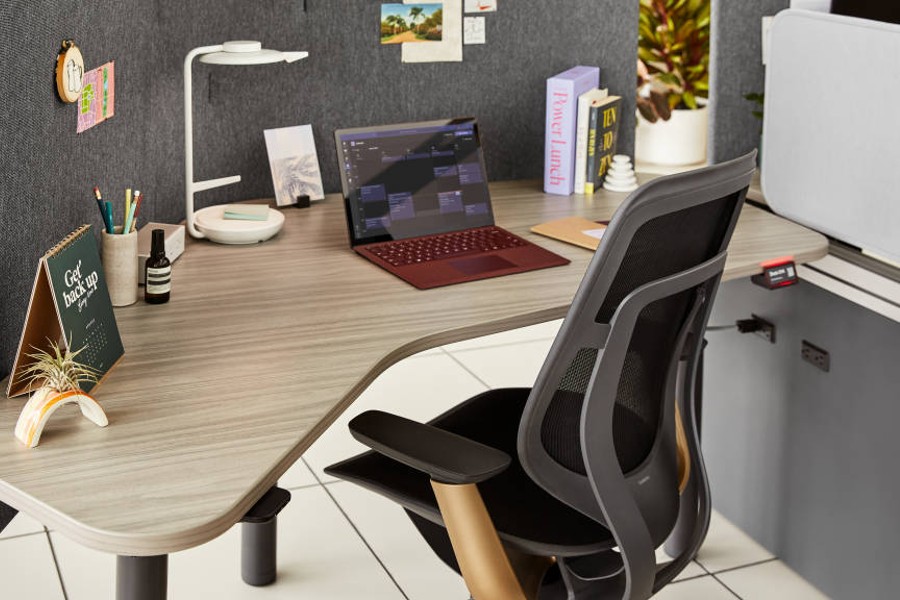
By HWM Team
In the landscape of contemporary office culture, the cubicle office remains a staple feature.
Love it or loathe it, the cubicle office has been a mainstay of workplace design for decades, evolving from its inception in the early 1960s to adapt to changing work practices and technology. Despite its critics decrying it as a symbol of corporate monotony and soul-crushing conformity, the cubicle office actually offers a myriad of benefits and opportunities for both employers and employees.
A Brief History
The concept of the cubicle office originated with designer Robert Propst, who envisioned it as a flexible and efficient alternative to traditional open-plan offices. Introduced by Herman Miller in 1968 under the name “Action Office,” the original design featured modular panels that could be configured to create individual workspaces, providing employees with privacy and autonomy while still fostering collaboration and communication.
Over the years, the cubicle office has undergone numerous transformations, influenced by factors such as advances in technology, changes in organizational structure, and shifting attitudes toward workplace design. Today, cubicles come in various shapes and sizes, ranging from simple, low-walled partitions to fully enclosed pods equipped with ergonomic furniture and integrated technology.
Benefits of Cubicle Offices
Contrary to popular belief, cubicle offices offer several advantages for both employers and employees. For employers, cubicles provide a cost-effective solution to space management, allowing them to maximize floor space and accommodate a larger workforce without resorting to expensive office expansions. Additionally, the modular nature of cubicles makes it easy to reconfigure the layout to adapt to changing needs and departmental reorganizations.
From an employee perspective, cubicle offices offer a balance between privacy and collaboration. While traditional open-plan offices can be noisy and distracting, cubicles provide a degree of separation that enables employees to focus on their work without constant interruptions. At the same time, the open design of cubicles encourages spontaneous interactions and impromptu meetings, fostering a sense of camaraderie and teamwork among colleagues.
Moreover, cubicle offices offer opportunities for personalization and customization, allowing employees to create a workspace that reflects their personality and preferences. From family photos and potted plants to quirky desk accessories and motivational posters, employees can imbue their cubicles with a sense of identity and belonging, enhancing morale and job satisfaction.
Challenges and Solutions
Despite their many benefits, cubicle office is not without their challenges. One common criticism is the lack of privacy and noise control, as the low walls of cubicles offer limited sound insulation and visual privacy. Additionally, the monotony of cubicle-filled landscapes can contribute to feelings of isolation and disengagement among employees.
To address these challenges, employers can implement strategies to improve acoustics and enhance privacy within cubicle offices. This may include installing sound-absorbing materials such as acoustic panels or carpets, as well as providing employees with noise-canceling headphones or private meeting rooms for confidential discussions. Moreover, employers can create designated quiet zones or breakout areas where employees can retreat for focused work or informal gatherings away from the hustle and bustle of the main office floor.
Furthermore, employers can foster a sense of community and belonging within cubicle offices by organizing team-building activities, social events, and wellness programs that encourage interaction and collaboration among employees. By creating a positive and supportive work environment, employers can mitigate the potential drawbacks of cubicle offices and promote employee engagement and satisfaction.
Looking to the Future
As we continue to adapt to the ever-evolving landscape of work, the cubicle office is likely to undergo further transformations to meet the needs and expectations of the modern workforce. With advancements in technology enabling remote work and flexible scheduling, the role of the physical office space is evolving, shifting from a centralized hub for daily operations to a flexible environment that supports collaboration, creativity, and well-being.
However, despite the rise of remote work and coworking spaces, the cubicle office remains a relevant and practical solution for many organizations, offering a balance between privacy and collaboration that is difficult to replicate in other environments. By embracing innovative design principles, technology, and workplace practices, the cubicle office will continue to evolve and adapt to meet the changing needs of employers and employees alike, ensuring its place as a cornerstone of modern office culture for years to come.
- Wells Fargo Shares Economic Impact From Open For Business Fund
- Harlem Rallies For Kamala Harris: A Historic Gathering Of Black Women Leaders
- In Conversation With Ketanji Brown Jackson At The Apollo Theater In Harlem
- Chancellor David C. Banks Appoints Simone Hawkins As Deputy Chancellor For Early Education
- Vibrant Summer Styles Are Making A Comeback 2024
Become a Harlem Insider!
By submitting this form, you are consenting to receive marketing emails from: Harlem World Magazine, 2521 1/2 west 42nd street, Los Angeles, CA, 90008, https://www.harlemworldmagazine.com. You can revoke your consent to receive emails at any time by using the SafeUnsubscribe® link, found at the bottom of every email. Emails are serviced by Constant Contact









